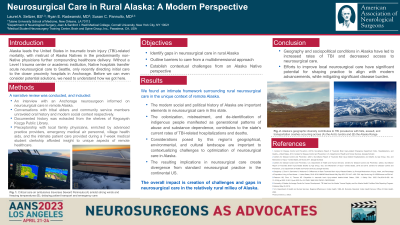Neurosurgical Care in Rural Alaska: A Modern Perspective
Friday, April 21, 2023


Laurel A. Seltzer (she/her/hers)
Medical Student
Tulane University School of Medicine
New Orleans, Louisiana, United States
ePoster Presenter(s)
Introduction: Alaska leads the United States in traumatic brain injury-related mortality, with mistrust of Alaska Natives in the predominantly non-Native physicians and lack of a tertiary care center further compounding healthcare delivery. Before we can even consider potential solutions, we need to understand how we got here.
Methods: A narrative review was conducted. An interview with one of Anchorage’s neurosurgeons provided information on neurosurgical care in remote Alaska. Conversations with tribal elders and community service members unraveled oral history and modern social context respectively, corroborated by documented history extracted from the shelves of Kegoayah Kozga Public Library. Preceptorship with local family physicians, enriched by advanced practice providers, emergency medical air personnel, village health aids, and the intimate patient care provided during a 7-week medical student clerkship afforded insight to unique aspects of remote healthcare.
Results: We found an intimate framework surrounding rural neurosurgical care in the unique context of remote Alaska. First, the modern social and political history of Alaska are important elements in neurosurgical care in that state. The colonization, abuse, and de-identification of indigenous people manifested as generational patterns of abuse and substance dependence, contributes to the state’s current rates of TBI-related hospitalizations and deaths. Second, considerations posed by this region’s geographical, environmental, and cultural landscape are important to contextualizing challenges to optimization of neurosurgical care in Alaska. The resulting implications in neurosurgical care create divergence from standard neurosurgical practice in the continental US. The overall impact is creation of challenges and gaps in neurosurgical care in the relatively rural milieu of Alaska.
Conclusion : Geography and sociopolitical conditions in Alaska have led to increased rates of TBI and decreased access to neurosurgical care. Efforts to improve local neurosurgical care have significant potential for shaping practice to align with modern advancements, while mitigating significant disease burden.
Methods: A narrative review was conducted. An interview with one of Anchorage’s neurosurgeons provided information on neurosurgical care in remote Alaska. Conversations with tribal elders and community service members unraveled oral history and modern social context respectively, corroborated by documented history extracted from the shelves of Kegoayah Kozga Public Library. Preceptorship with local family physicians, enriched by advanced practice providers, emergency medical air personnel, village health aids, and the intimate patient care provided during a 7-week medical student clerkship afforded insight to unique aspects of remote healthcare.
Results: We found an intimate framework surrounding rural neurosurgical care in the unique context of remote Alaska. First, the modern social and political history of Alaska are important elements in neurosurgical care in that state. The colonization, abuse, and de-identification of indigenous people manifested as generational patterns of abuse and substance dependence, contributes to the state’s current rates of TBI-related hospitalizations and deaths. Second, considerations posed by this region’s geographical, environmental, and cultural landscape are important to contextualizing challenges to optimization of neurosurgical care in Alaska. The resulting implications in neurosurgical care create divergence from standard neurosurgical practice in the continental US. The overall impact is creation of challenges and gaps in neurosurgical care in the relatively rural milieu of Alaska.
Conclusion : Geography and sociopolitical conditions in Alaska have led to increased rates of TBI and decreased access to neurosurgical care. Efforts to improve local neurosurgical care have significant potential for shaping practice to align with modern advancements, while mitigating significant disease burden.
